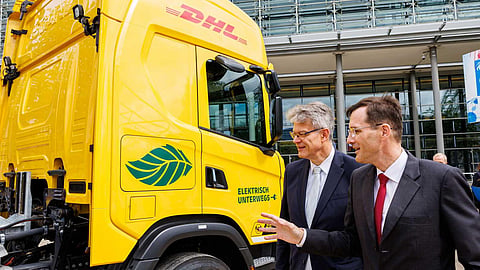100-day DHL Test: New Scania e-Truck Saves 90% CO2 Emissions
DHL Group has unveiled the 'Extended Range Electric Vehicle' (EREV), developed in collaboration with heavy vehicle maker Scania, at the OECD International Transport Forum in Leipzig.
The EREV is an electric truck equipped with a fuel-powered backup generator that generates electricity to recharge the batteries when they are running low.
This new truck concept is being extensively tested by DHL for package transport between Berlin and Hamburg. The results after the first 100 days are very positive: the EREV covered nearly 22,000 kilometers, operating more than 90% of the time in electric mode.
The range extender was activated in only about 8.1% of the kilometers driven. As a result, the EREV saved more than 90% of CO2 emissions compared to a conventional diesel truck during the testing period.
At the same time, it enhances operational flexibility by providing an additional energy reserve when no charging station is available, unlike a fully electric truck. The generator itself cannot directly drive the vehicle's drive axle.
In that sense, the EREV is different from conventional hybrid vehicles and a novel concept with great potential to support the transition to electrified transport, both for the transport operator and the transport system.
The test between the DHL parcel centers in Berlin and Hamburg demonstrated that the EREV is a practical and, above all, sustainable means of transport for logistics.
However, for bridging technologies like the EREV to gain traction in the transport sector, appropriate regulatory frameworks are needed.
Tobias Meyer, CEO of DHL Group, stated: 'We all, businesses, politics, and society - want fewer emissions through increased e-mobility in freight transport.
"At the same time, all experts know that the transition to fully electric trucks will take many years, primarily because the grid and charging infrastructure are inadequate.
"But we should not be forced to wait. We need pragmatic solutions like the EREV and quick political decisions to enable such bridging technologies. We want to decarbonize the transport sector now and regulation should not hinder but support us to do so."
The successful test of the EREV has shown that this vehicle's environmental performance can come close to that of a full electric truck. The calculation of road tolls and the emission values for the EU fleet emission scheme should reflect the actual or realistically expected emissions, which is currently not the case for the EREV.
A vehicle should pay the CO2 truck toll according to its effective greenhouse gas emissions. Policymakers should support this by introducing an additional emissions class that recognizes proportional CO2 emissions reductions under road toll legislation, based on certified emissions.


